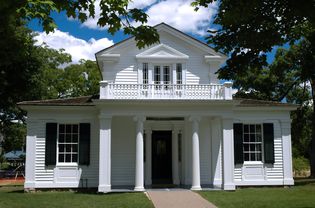You may not have heard of Andrea Palladio or his widespread architectural influence, but it’s likely that you’ve seen Palladian architecture without ever realizing it. This style can be seen around the world, often chosen for prominent government buildings. It may even be evident in your neighborhood or home—especially in the form of Palladian windows, which are popular for letting in large amounts of light.
Learn more about the history of this Renaissance style and its influence on architecture throughout history, right down to today.
History of Palladian Architecture
The man behind the inception of Palladian architecture is Andrea Palladio, who lived from 1508 to 1580. During his career in Europe as an architect, he sought to incorporate classical elements from ancient Greek and Roman design into more contemporary uses. Like neoclassicism, his designs focused on proportion and symmetry. However, his architectural style sought to find new ways of including classical elements, rather than adhering to more strict or narrow interpretations. The result of Palladio’s work gave birth to a new architectural style—Palladian architecture.
Palladian architecture spread throughout Europe, increasing in use and popularity by other architects such as Inigo Jones and Lord Burlington. It offered familiar classical design elements that appealed to European aristocracy, but wasn’t so rigidly tied to specific forms and motifs popular in the designs of antiquity.
The catalyst for Palladian architecture emerging in North America was the translation of Palladio’s published design books into English, which occurred from 1715 to 1720. As a result, Palladian architecture began to take hold in North America, especially during the 18th and 19th centuries. Thomas Jefferson was a major proponent of this design style, calling the works of Palladio his “architectural Bible.” Some of Jefferson’s most famous projects that feature Palladian elements include the University of Virginia, Monticello, and the Virginia State Capitol. These projects, along with other prominent buildings, had a large influence on the increasing popularity of Palladian architecture in the United States.
Key Characteristics
Palladian architecture is famous for its stately symmetry, classical elements, and grand appearance. Columns and pillars, such as Corinthian columns, are often seen supporting open structures or porticos. Symmetry is an important feature of this style, with each half of a building mirroring the other. Windows are placed in a perfectly symmetrical style, creating order. Domed ceilings and windows grace these buildings as a nod to ancient Roman and Grecian temples. Everything is placed in a mathematical arrangement.
The overall air of Palladian architecture captures a stately, grand, and austere feeling. Whether it be on large, governmental buildings or smaller housing, Palladian elements bring a sense of ancient strength and refinement.
Though the outside architecture captures the clean, symmetrical, and austere aesthetics of ancient buildings, the inside of Palladian structures is often adorned in lavish, regal décor. This concept of congruent contrast is often attributed to Inigo Jones, who combined the ancient elements with luxurious elements such as fireplaces, textiles, and sculptural pieces. It's no surprise that Jones married opulent interiors with Palladian architecture. One of his most well-known projects was the Queen’s House, built in Greenwich, England completed about 1635. This influential project is seen as the start of English Palladianism.
Palladian Architecture Today
Bold Palladian architecture is not commonly seen among modern designs today, but this style still lives through historical buildings and in key elements incorporated throughout other design styles. Large, symmetrical, and portico-front estates in the south are prime examples of Palladian architecture living on through the ages. Large government buildings such as state capitols or university buildings often sport Palladian porticos and orderly symmetry.
In residential design, Corinthian columns may be seen supporting a portico, small or large, in the front of a house. The idea of keeping the exterior symmetrical and orderly is also a nod to Palladian architecture. However, windows are the most common element to be influenced by Palladian architecture.
:max_bytes(150000):strip_icc()/BeachhousewithPalladianwindows-82a3cb1a0b0648deb870040631e43f4b.jpg)
wbritten / Getty Images
Palladian windows are made of three sections, with the center section boasting a tall, dome shape at its peak. This symmetrical, grand window pattern incorporates the classical feeling of Palladian architecture even in more modern, contemporary buildings. Large Palladian windows may grace a living room or dining room with an abundance of natural light and a grand air.
:max_bytes(150000):strip_icc()/Erica-Puisis-c39951085ba54f3db917710a5ec48084.jpg)
:max_bytes(150000):strip_icc()/_DSC3035-89e8764848db4aa6901d9451b9b15923.jpeg)
:max_bytes(150000):strip_icc()/HousewithPalliadianArchitecture-0932822e249c46988e6856c98ac73c50.jpg)

